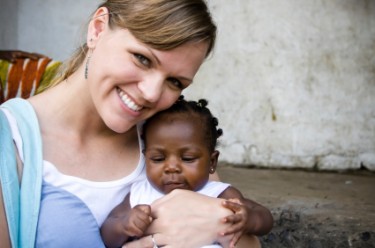
Today’s families are increasingly multicultural and multiracial. Research has a found that transracial families thrive, but transracial parenting must be intentional parenting. Many parents think that love is enough to overcome racial and cultural differences between themselves and their child, but they must also create a diverse community of people in their life to offer their child familiar and comfortable role models.
Parents should make and keep plenty of positive mentors and friends to help their child build a healthy racial identity. Ideally, choices of where to live and social groups to be a part of should be considered and acted upon prior to adopting. No matter what, your child should not be the only person of his or her race or ethnicity in your life.
Here are nine suggestions on how to create a welcoming and inclusive community.
Notice other adults of your child’s race, ethnicity, or culture in your daily life.
Engage in a conversation, and if you have something in common, go out of your way to form a friendship. Remember, all friendships take effort and time. When you’re ready, try something open and easy such as; “Hi. This may sound strange, but I’d like to get to know you more and invite you and your family to meet up with ours next week.” Keep it light, simple, and easy. Meeting at a park, or other public space, allows children to run around while adults connect and talk.
Be direct!
For example: “I’m looking for some support. Most of my friends look like me or my partner and I’m eager to create a larger community for all of us to learn more about our child’s identity and culture. Would you like to go out sometime this week?”
Read Next | This Is What It’s Like When a Child Prefers One Parent
Attend a cultural event.
Celebrate and recognize your child’s race, ethnicity, or culture. If you are spiritual, attend a place of worship whose congregation is predominantly of your child’s race/ethnicity. Become active and connect with others. In addition to making friends, the experience of being in the minority can provide insight to what your child may experience every day.
Be aware of your own privilege.
Whenever possible, speak out against racial injustices that occur within your sphere of influence. Your child will want to know that you are an advocate and an ally.
Read Next | The Recipe for Better Parenting? Just Add Sleep!
Discuss your child’s uniqueness.
Be open to his or her potential vulnerabilities about their differences. Talk to your child in age-appropriate ways about race, ethnicity, culture, and discrimination, in the same way you talk to your child about their adoption story and birth family.
Commit to honesty.
If you are in an open adoption with your son or daughter’s birth parents, talk about fears, worries, and preconceived ideas you may have about one another. Never speak negatively about your child’s birth parent(s) or stigmatize their race, ethnicity, or culture.
Choose professionals wisely.
While it is the people who visit your home and join you for dinner who will most likely be role models for your child, it is also beneficial to choose professionals, such as pediatricians or educators, who share the race or ethnicity of your child.
Make your home one that embraces your child’s culture.
You can do this by incorporating art, books, and toys that acknowledge your child’s identity. Encourage your friends and family to get on board. For example, educate your relatives on the importance of giving your child racially congruent dolls.
Create a family culture and identity.
Embrace being a multicultural, transracial family and remember that your entire family is on this journey together, not just your child.

Read Next | This Is How Breathing Techniques Can Reduce Anxiety in Children
Dana Stallard, LMSW is Manager, Community Programming at Spence-Chapin’s Modern Family Center
The views and opinions expressed on this blog are purely the blog contributor’s. Any product claim, statistic, quote or other representation about a product or service should be verified with the manufacturer or provider. Writers may have conflicts of interest, and their opinions are their own.



